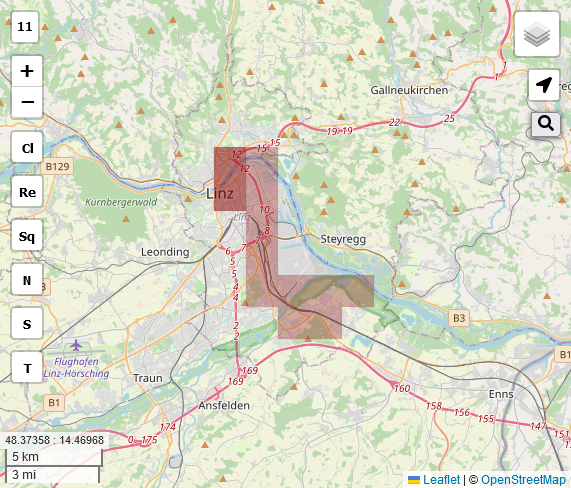This project can be used to read tracks from GPX files and produce a web-page which displays covered "tiles" on a world map with some advanced features not found on the usual "tile hunting" websites.
The sport of physically visiting as many tiles (i.e. square areas) as possible on the map is often known as "tile-hunting".
This project can be used both as library in other projects and directly as a set of applications which process data so that you can visualize your covered "tiles" on a web page.
The flow of data is roughly as follows
GPX files -> list of covered tiles (txt) -> GeoJSON file for map-display (js) -> HTML page
It should be fairly easy to rebuild the map with data from your own tracks. Also adding more tracks over time is supported by visualizing "new" tiles and also allowing to do the CPU-intensive tasks of producing static images only for areas touched recently.
The processing and the map should scale up to large numbers of visited tiles
square: a 1km x 1km square on the maptile: a square on the map with roughly a mile side-length, based on zoom level 14 of the map at https://www.openstreetmap.org/ and other derived mapping siteslargest square: The largest area of tiles/squares that can be filled with a squarelargest rectangle: The largest area of tiles/squares that can be filled with a rectanglelargest cluster: The largest area of tiles/squares that can be filled with a rectanglenew squares/tiles: Each time the application runs and processes new GPX tracks, it allows to visualize which tiles have been newly coveredadjacent tiles: For planning upcoming routes, it is useful if you see a grid on the map for tiles which are not covered yet. The code produces so-called "adjacent tiles" which show a border around tiles "near" already covered ones, thus allowing you to see where exactly you need to go when you are out hunting some more tiles
You can directly open the provided file leaflet-map.html locally in a web-browser to see how this looks like. (It won't work on Github directly because it would need files to be served with proper content type).
A sample image with the two sample GPX tracks looks as follows
You can also host the resulting files on a web-server to make your covered tiles available online.
On the left side:
- Shows OSM zoom level
- Allows to zoom in/out
- Loading indicator when data is still loading
- Allows to toggle "largest cluster"
- Allows to toggle "largest rectangle"
- Allows to toggle "largest square"
- Allows to toggle "new" squares/tiles
- Allows to display covered "squares", i.e. 1km x 1km areas
- Allows to display covered "tiles", i.e. aprox. 1mile x 1mile areas
On the right side:
- Menu button which allows to switch to different maps and enable/disable various overlays
- GPS toggle: if used on a device which has GPS signal, this enables a marker for your current position
- Search: Allows to use the "nomination" service of OSM to search for locations
Either put GPX files into the directory gpx or replace the directory gpx with a symlink to your GPX files
or adjust the code to look elsewhere.
A popular tool for fetching GPX tracks from Garmin Connect is garmin-connect-export
A sample commandline to fetch all GPX files from an account is as follows:
python3 gcexport.py --directory ~/.garmin --unzip --format gpx --username "${GARMIN_EMAIL}" --password "${GARMIN_PASS}" --count "all"
Run the application org.dstadler.ctw.CoverTheWorld, e.g. via Gradle:
./gradlew updateFiles
In order to prepare additional "static" tiles, you can run additional applications:
org.dstadler.ctw.tiles.CreateTileOverlaysFromTiles: Create static overlay tiles (transparent PNGs with covered area in red)org.dstadler.ctw.tiles.CreateTileOverlaysFromUTMRef: Create static overlay squares (transparent PNGs with covered area in red)org.dstadler.ctw.tiles.CreateAdjacentTileOverlaysFromTiles: Create static overlay images for adjacent tiles (transparent PNGs with area with red border)org.dstadler.ctw.tiles.CreateStaticTiles: Create PNGs with OSM map image and the covered area combined into one image. This requires a running OSM tile-server to provide map tiles, which is currently not described here, see openstreetmap-tile-server for a docker-based way to spin up a tile-server which can render some parts of the world.
These PNGs can be useful to get the map of covered tiles displayed in other applications, at least the following are known to work:
- GpsPrune: Can use the static overlay tiles as 2nd map
- OsmAnd: Can use the static overlay tiles as 2nd map
- Komoot: It is possible to replace the map in the Komoot web application with the combined PNGs produced via
CreateStaticTiles, however this requires some more advanced scripting via e.g. TamperMonkey which is currently not (yet) described here
The code can also be included as a library in your own application, e.g. this might be useful if you want to automate things in some more advanced way.
implementation 'org.dstadler:cover-the-world:1.+'
Currently, computing the largest squares is limited to a single zone of
the UTM coordinate system. By default zone "33" is used. You can adjust
this in org.dstadler.ctw.utils.Constants.ZONE and re-run to produce the
proper largest squares if you are located in another UTM zone.
This limitation does not apply for the 1mile x 1mile tiles.
The limitation is needed because the algorithms for computing distances would become much more complicated.
Would be cool to get rid of this limitation, let me know via issues/PRs if you have ideas how to do a whole-world computation efficiently.
git clone git://github.com/centic9/cover-the-world
cd cover-the-world
./gradlew check jacocoTestReport
./gradlew --console=plain release && ./gradlew closeAndReleaseRepository
- This should automatically release the new version on MavenCentral
- Afterwards go to the Github releases page and add release-notes
If you find this library useful and would like to support it, you can Sponsor the author
- cover-the-world is licensed under the BSD 2-Clause License.
- Currently includes a compiled version of jCoords




